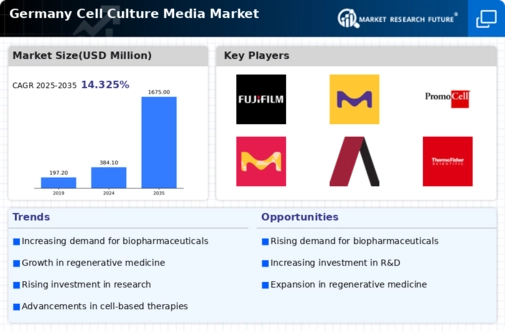Increased Regulatory Compliance
The cell culture-media market in Germany is also shaped by the evolving landscape of regulatory compliance. Stricter regulations governing biopharmaceutical production and quality assurance have prompted manufacturers to invest in high-quality cell culture media that meet these standards. The German Federal Institute for Drugs and Medical Devices (BfArM) has implemented guidelines that emphasize the importance of using validated media in research and production processes. This regulatory environment encourages companies to innovate and improve their media formulations, ensuring they align with compliance requirements. As a result, the cell culture-media market is likely to witness growth as manufacturers adapt to these regulations, enhancing the overall quality and reliability of their products.
Expansion of Research Institutions
The proliferation of research institutions and universities in Germany is a key driver for the cell culture-media market. With a strong emphasis on life sciences and biotechnology, these institutions are increasingly engaged in cutting-edge research that necessitates the use of specialized cell culture media. Recent data indicates that research funding in Germany has reached approximately €3 billion, with a significant portion allocated to projects involving cell culture techniques. This influx of funding fosters collaboration between academia and industry, leading to the development of innovative media solutions tailored for specific research applications. As a result, the cell culture-media market is poised for growth, driven by the continuous demand for high-quality media from these research entities.
Rising Biopharmaceutical Investments
The cell culture-media market in Germany is experiencing a notable surge due to increasing investments in biopharmaceutical research and development. In recent years, the German government has allocated substantial funding to support innovative healthcare solutions, which has led to a heightened demand for advanced cell culture media. This investment trend is expected to continue, with projections indicating a growth rate of approximately 8% annually in the biopharmaceutical sector. As a result, the cell culture-media market is likely to benefit from the need for specialized media that can support the production of complex biologics and monoclonal antibodies. Furthermore, the presence of leading biopharmaceutical companies in Germany enhances the market landscape, creating a robust ecosystem for cell culture applications.
Growing Focus on Personalized Medicine
The cell culture-media market is significantly influenced by the increasing emphasis on personalized medicine in Germany. As healthcare providers and researchers strive to develop tailored therapies, the demand for specific cell culture media that can support individualized treatment approaches is on the rise. This trend is reflected in the growing number of clinical trials focused on personalized therapies, which have increased by over 15% in the past year. Consequently, the cell culture-media market is adapting to meet these needs, with manufacturers developing innovative media formulations that cater to diverse patient profiles. This shift not only enhances treatment efficacy but also drives the demand for high-quality cell culture media, thereby propelling market growth.
Technological Integration in Production
The integration of advanced technologies in the production of cell culture media is a significant driver for the market in Germany. Innovations such as automation, artificial intelligence, and data analytics are transforming the way cell culture media is developed and manufactured. These technologies enable manufacturers to optimize production processes, reduce costs, and enhance product consistency. Recent studies suggest that the adoption of automated systems in media production can lead to efficiency improvements of up to 30%. As companies increasingly embrace these technological advancements, the cell culture-media market is expected to expand, driven by the demand for high-quality, reproducible media that can support various applications in research and biopharmaceutical development.





















Leave a Comment